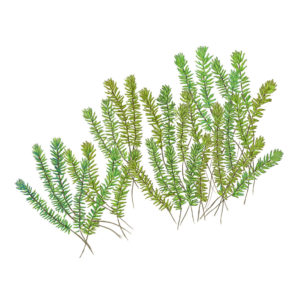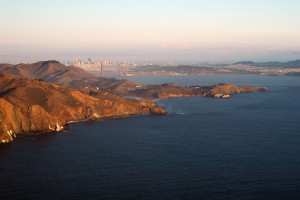hen the first live eastern oysters came to the Bay Area by train in the late 1800s, Victorian-era foodies lined up to buy them by the box at four dollars for 200. Capitalizing on San Franciscans and their love of trendy food, would-be oyster farmers followed, hoping to raise their imported shellfish in the Bay.
But life proved difficult for the farmers, and their oysters. For the preferred eastern oyster (Crassostrea virginica), summers in the Bay Area were too hot and dry, stingrays too hungry, and one particular “parasite” far too fast-growing for the bivalve to take hold, as the naturalist Charles Townsend wrote in 1893. “It is possible that I have not attached sufficient importance to the evil of overcrowding,” Townsend declared, by this “remarkably fertile” competitor.
The so-called parasite was the once-abundant Olympia oyster (Ostrea lurida), the West Coast’s and the Bay’s only species of native oyster. But in the years since Townsend wrote about them, the public’s attitude has changed. Dismissed as “worthless” a century ago, native oysters are now one of the key parts of an ambitious idea to restore the Bay’s health and simultaneously protect people and land from the danger of sea level rise.
The densely populated and expensively developed Bay Area is also home to one of the largest wetland restoration projects in the country. Millions of dollars and hours have been spent refashioning the margins of the Bay, but it’s become clear that under some future climate change scenarios, rising seas could erode and drown much of that work.
By conservative predictions, the water level in the Bay could rise between 36 and 55 inches by the end of this century. More frequent storms with powerful surges and higher tides will lead to increased flooding — with today’s king tides just a preview of the challenges to come.
There is an obvious solution, one arrived at by the Dutch in the Middle Ages: build a wall. In some places, like the heavily urbanized shores of San Francisco, that might be the solution. But the hard engineering solution isn’t always ideal. You have to repair seawalls, and sometimes rebuild them. And a wall does little for the ecological health of a Bay that’s significantly degraded from the biologically rich body of water enterprising 19th-century oyster farmers toiled in.
So a few years ago the State Coastal Conservancy went looking for another option: habitat restoration that would also address sea level rise. Borrowing a concept from the East Coast, the conservancy and its partners came up with the San Francisco Bay Living Shorelines Project, a pilot-scale experiment to restore native oysters by the million and test the idea of a new kind of shoreline at selected sites around the Bay. Two years into the experiment, the results suggest that in the appropriate places this green climate adaptation might work.
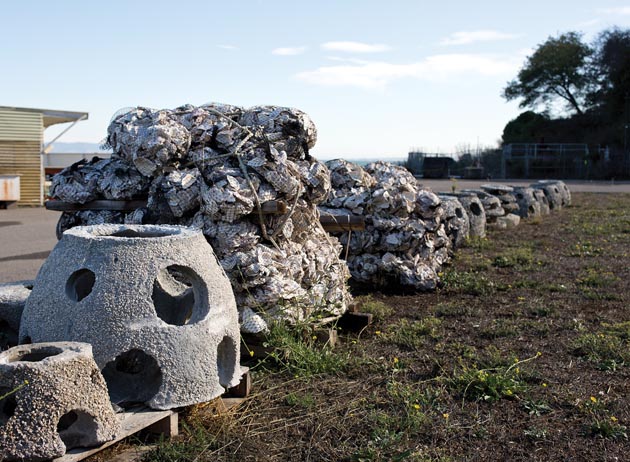
Along the riprap of the San Rafael Bay shoreline, native oyster shells litter the mud between the rocks made jagged by the crunchy remnants of a gone-but-not-forgotten population of Olympic oysters.
On a dry winter day, the tide is receding and a crenellated line of shell bag mounds and reef domes and castles begins to appear out of the exposed mud. This is the prototype of the Living Shoreline: an experimental nearshore habitat for oysters.
As the twilight hour nears, two wetsuit-clad scientists from the Romberg Tiburon Center lab of Dr. Katharyn Boyer slog through a foot of water and a foot of mud toward the oysters, with a boogie board and various instruments in tow. The thick mudflat bubbles with each footfall as they make their way across, careful not to slow their pace lest they get stuck and sink. Their goal this evening is to gather water quality data and take some samples using a fish-tank vacuum to see what’s living at the site—part of the Boyer lab’s regular monitoring of the reefs.
The structures, now covered in millions of native oysters, are the first small test of three questions: What’s the best way to restore native oysters (and their partner-in-habitat eelgrass) to the Bay? What effect does their restoration have on the rest of the ecosystem? And how do those oyster reefs change the dynamics of waves and storm surge heading toward shore?
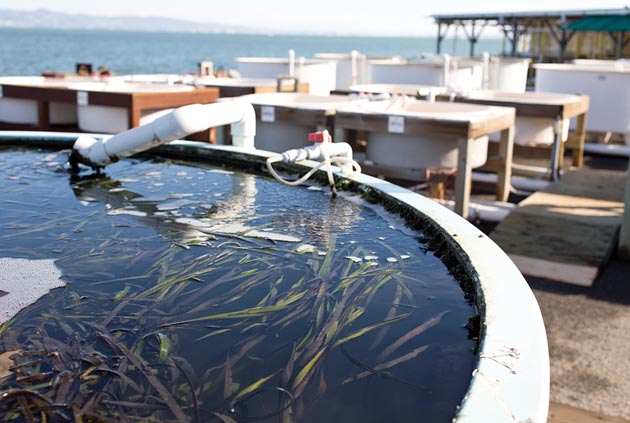
Baby oysters require a solid surface to settle on. Larvae float through the water until they find a suitable spot to attach to and mature. The project designed a variety of artificial reefs to see which materials and which shapes would collect the most native oysters.
In 2012, in the shallow waters of the San Rafael shoreline, the team dropped bagged shells of Pacific oysters—a species native to Asia—provided by the Drakes Bay Oyster Company in Point Reyes. The thousands of oyster shells, cured for two years in the sun and packed into three-foot-by-one-foot bags, were placed in the water in a carefully designed pattern to give the researchers the ability to compare both restoration success and physical effects in different conditions.
Off San Rafael and at a separate site miles to the south at Eden Landing Ecological Reserve in Hayward, the team is also testing varying styles of human-made “baycrete” (a home-brewed concoction of concrete mixed with native oyster shell and sand mined from the Bay) structures to see what artificial surfaces and orientations oysters prefer. (Oysters prefer settling on oyster shells, but since a major point of this pilot project is anticipating future needs and much larger scales, it’s worth exploring other options.)
The project team then fashioned baycrete reefs: domes, stacks of domes, “layer cakes,” and castle-shaped “oyster blocks” where oysters and fish can live. Each model has a different configuration of surface areas, horizontal and vertical spaces, and varying amounts of hiding space. The preliminary results suggest oysters like the dome and block structures; the layer cakes not so much.
The San Rafael site has also been designed to test varying methods for the restoration of another formerly abundant but now threatened Bay species, eelgrass. By planting plots of eelgrass interspersed with the large oyster beds, Boyer and her team are investigating the relationship between the two: how they might help each other, and how they might work together to help the ecosystem.
The general theory goes that the filter-feeding oysters can improve water clarity. That helps eelgrass grow because more sunlight can reach the otherwise murky Bay bottom. Eelgrass in turn might influence the particle size of food floating in the water, making it more palatable to native oysters. The oyster reefs might help protect eelgrass from wave energy. Eelgrass also makes important habitat for other invertebrates and other plants. Its roots could also help stabilize sediment, which would offer more shoreline protections.
More importantly, oysters and eelgrass are two cornerstones of the Bay’s subtidal habitat. Our options for future climate adaptation are constrained by available land, says Environmental Science Associates geomorphologist Jeremy Lowe, and so the Bay’s intertidal and subtidal margins—almost all of it state-owned—offer some of the most promising terrain for building nature-based adaptation measures. Oysters and eelgrass thrive in the subtidal, and so can be restored together. This is one of the first scientific attempts at asking the question: Should they be?
With the reefs in place, Boyer said it’s been exciting to see the development of habitats used by wildlife. Wading birds like egrets and black oystercatchers normally hunt for food on the shoreline. At the experiment sites, the birds can be seen further offshore, stalking and pecking at prey between reefs and eelgrass beds.
Over the course of a year, the one-acre project area in San Rafael had recruited two million oysters, according to an October 2013 report. The oyster reefs provide habitat niches for small crabs and other invertebrates, which are food for fish, birds, and mammals. Fish can hide among the reefs and eelgrass and feed on the smaller creatures that live there. Salmon have visited some of the project’s test reefs, and Boyer said sevengill shark and steelhead are also making use of the structures. “We’ve even had sturgeon stopping by,” Boyer said. “It’s a boon to a large array of organisms.”
Both oysters and eelgrass are having a harder time at the Hayward site. The invasive Atlantic oyster drill, a predatory sea snail that feasts on small oysters, has helped keep oyster populations at Eden Landing low. Two separate small eelgrass plantings failed to take, although the second established for a few months before mostly disappearing—possibly, Boyer says, because there are so many non-native eastern mudsnails laying eggs at the site that they weighed down the eelgrass. The Hayward site also seems to have an unexplained influx of sediment, unrelated to the project, which might have buried the plants.
The varying success rates at the two sites further bolster the project’s big idea: Oyster reefs and eelgrass could be a valuable part of the future Bay. But we also know they won’t work everywhere—the Hayward shoreline may be such a place—and before we go big on living shorelines, we need to know why. This is, after all, how science works: Understanding negative results is just as important as getting positive ones.
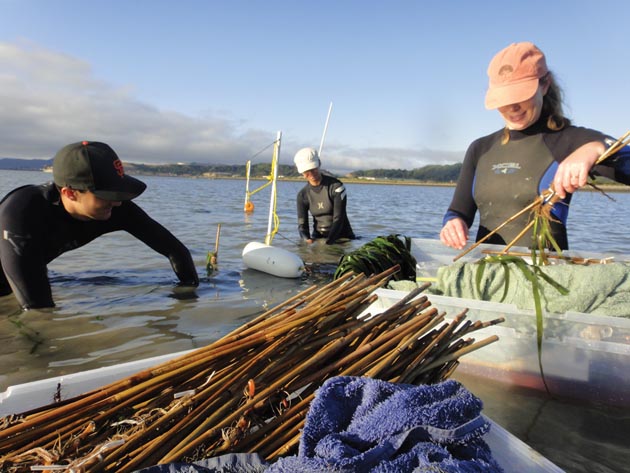
The habitat restoration is just part one. There’s also the climate component: the potential that the reefs could help protect the tidal marsh edges from erosive waves.
A wave starts in deep water, losing speed from friction as it moves across the shallow Bay and mudflats. When a wave reaches an oyster reef, it “trips,” losing even more energy before it reaches shore. While sea level rise calls to mind a slow drowning of the Bay Area, like filling a bathtub, the bigger problem is storm surges that could overwhelm levees and cause widespread sudden flooding, like the flooding that follows hurricanes on the East Coast. Although we don’t have hurricanes, the Bay’s combination of open water and regular wind can result in large waves for an inland body of water. And that’s where sea level rise matters most: the higher the water starts out, the worse the effects of those surging waves.
At the San Rafael site, the project team installed four acoustic Doppler current profile monitors, wave gauges that lie in the mud and measure, at a very fine scale, the height of waves moving by overhead. Wave height is a function of wave energy, so with a lot of observation and a bit of math thrown in, the team found that the reefs in San Rafael are reducing the energy of incoming waves by 30 to 50 percent, with the effect greatest at average tides.
Oyster reefs are widely used as shoreline protection on the East Coast, so the effect isn’t particularly surprising. What’s new with the Living Shoreline Project is both its specific application in San Francisco Bay—where living shorelines are still a new concept—and its design to consider habitat restoration first. Some East Coast living shorelines, Lowe says, tend to just be break-waters first with oysters added on. This project, with its comprehensive monitoring of oysters, eelgrass, invertebrate life, vertebrate life, sediment health, and water quality, asks questions about how to achieve the best habitat in San Francisco Bay and provides answers specific to the Bay.
“We’re testing concepts that we can then apply to future projects, that could have more protective benefits if they were larger,” says Marilyn Latta, the Living Shoreline project manager at the State Coastal Conservancy.

While the project is still in a test phase, the idea behind it is grand. The Living Shoreline represents a creative way of responding to the threat of climate change with “green infrastructure.” Employing natural systems to support human ones is an idea that’s catching on, says Andy Gunther, executive coordinator of the Bay Area Ecosystems Climate Change Consortium. “It’s that kind of thinking that I hope we are going to be able to build more of,” he says.
Climate change means uncertainty. We know, Lowe says, essentially one thing: the direction of sea level, which is up. How much, and where, and how it will affect both human and natural systems, we don’t yet know. Somewhere down the road we’ll no doubt have to spend a lot of money protecting the coast. It’s nice to have an option that provides immediate habitat benefits, and the Living Shoreline is one first, pilot-scale step in unlocking that option.
“We do consider it a win-win, but we’re cautious about how much we can say about it at this point,” Boyer says. “There are big decisions we want to make as a society on how close to the shoreline we have our infrastructure. [And] oysters and our reefs are part of a solution that everyone, scientists and managers included, will have to address.”
When the reefs were first built, someone contacted Latta to ask how oysters could fix sea level rise, wondering if oysters, since they’re filter feeders, would just suck up all the water, saving the Bay from climate change. Latta gracefully responded that there are no bad questions.
But that question illustrates an unfortunate truth about climate change: There is no easy way out. There’s no magic oyster reef we’ll be able to throw into the water to drink away our problems. “Focusing on what might be the solution, and even small ways to adapt,” Latta says, “gives me great hope.”



